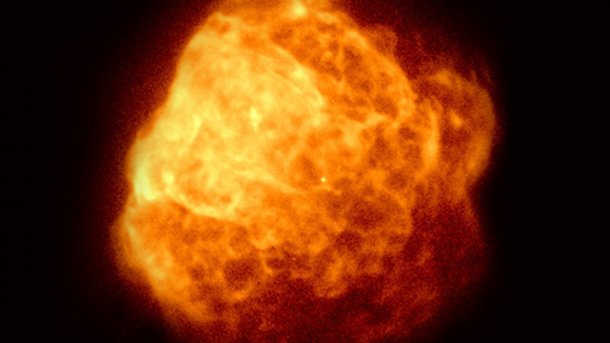"Einstein Probe" space telescope: Impressive image of supernova remnant
China's "Einstein Probe" space telescope searches the sky for transient sources in the X-ray spectrum. The first images now show the potential.

The instruments of the space telescope provide information about the composition of the supernova remnant Puppis A
(Bild: IHEP/CAS)
A Chinese space telescope launched at the beginning of the year has taken an impressive image of a supernova remnant as part of its commissioning. This has now been made public by the Max Planck Institute for Extraterrestrial Physics, which played a key role in the mission known as the "Einstein Probe". The image taken in the X-ray spectrum shows the object called Puppis A as a kind of fireball, in the middle of which the star that exploded around 4000 years ago can be seen. Another image of the X-ray telescope shows a view of the Milky Way, with particularly strong signal sources in a characteristic cross shape, which can be traced back to the mirror technology. Overall, the instrument fulfills all expectations, and in some cases even exceeds them.
(Bild: EPSC, NAO/CAS; DSS; ESO)
The Einstein Probe X-ray satellite was sent into space from the Chinese Xichang Cosmodrome early in January. Since then, it has been orbiting the earth at an altitude of around 600 km. With an enormously large field of view and particularly high sensitivity, the device is designed to detect and investigate variable sources of X-ray radiation. To do this, it can scan half the night sky in just five hours. It uses technology based on that used in the successful eRosita space telescope. The device is now to be further calibrated by mid-June and then commence regular research operations.
The satellite has already made a number of discoveries in the early test phase, adds the Max Planck Institute. Immediately after it was switched on, the Wide-Field X-ray Telescope (WXT) detected transient X-ray sources, as well as more than 100 outbursts of stars in the Milky Way visible in the X-ray spectrum. More than 20 hints have already been issued to astronomers around the world to trigger follow-up observations if necessary. The research institute also points out that the cooperation on the Einstein Probe satellite is the first with the Chinese Academy of Sciences. It worked perfectly, "we are already looking forward to the next one".
(mho)